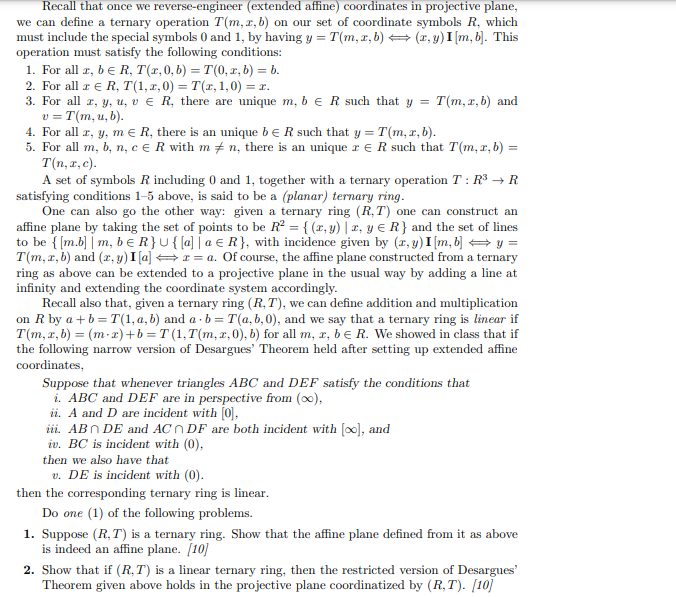
Recall that once we reverse-engineer (extended affine) coordinates in projective plane, we can define a ternary operation T(m, z,b) on our set of coordinate symbols R, which must include the special symbols 0 and 1, by having y = T(m,1,b) = (,y) I [m,b]. This operation must satisfy the following conditions: 1. For all 1, BERT(1,0,b) = T(0,r, b) = b. 2. For all 3 ERT(1,2,0) = T(2,1,0) = r. 3. For all r, y, U, V E R, there are unique m, b E R such that y = T(m, x,b) and v = T(m, u,b). 4. For all r, y, me R, there is an unique be R such that y=T(m, r,b). 5. For all m, b, n,ce R with m *n, there is an unique r e R such that T(m, 1,b) = T(n,x,c). A set of symbols R including 0 and 1, together with a ternary operation T: R3 +R satisfying conditions 1-5 above, is said to be a (planar) ternary ring. One can also go the other way: given a ternary ring (R.T) one can construct an affine plane by taking the set of points to be R = {(r,y) | , Y ER} and the set of lines to be { [m.b] |m, bERU{ [a] | R}, with incidence given by (1,y)I[m, b] =y= T(m,x, b) and (x,y)Ia ra. Of course, the affine plane constructed from a ternary ring as above can be extended to a projective plane in the usual way by adding a line at infinity and extending the coordinate system accordingly. Recall also that, given a ternary ring (R,T), we can define addition and multiplication on R by a +b=T(1, , b) and a b=1(a,b,0), and we say that a ternary ring is linear if T(m, , b) = (m-x)+b=T (1,7(m, 2,0), b) for all m, 1, be R. We showed in class that if the following narrow version of Desargues' Theorem held after setting up extended affine coordinates, Suppose that whenever triangles ABC and DEF satisfy the conditions that i. ABC and DEF are in perspective from (0), i. A and D are incident with (0), ii. ABNDE and AC DF are both incident with (00], and iv. BC is incident with (0), then we also have that v. DE is incident with (0). then the corresponding ternary ring is linear. Do one (1) of the following problems. 1. Suppose (R, T) is a ternary ring. Show that the affine plane defined from it as above is indeed an affine plane. (10) 2. Show that if (RT) is a linear ternary ring, then the restricted version of Desargues' Theorem given above holds in the projective plane coordinatized by (R, T). [10] Recall that once we reverse-engineer (extended affine) coordinates in projective plane, we can define a ternary operation T(m, z,b) on our set of coordinate symbols R, which must include the special symbols 0 and 1, by having y = T(m,1,b) = (,y) I [m,b]. This operation must satisfy the following conditions: 1. For all 1, BERT(1,0,b) = T(0,r, b) = b. 2. For all 3 ERT(1,2,0) = T(2,1,0) = r. 3. For all r, y, U, V E R, there are unique m, b E R such that y = T(m, x,b) and v = T(m, u,b). 4. For all r, y, me R, there is an unique be R such that y=T(m, r,b). 5. For all m, b, n,ce R with m *n, there is an unique r e R such that T(m, 1,b) = T(n,x,c). A set of symbols R including 0 and 1, together with a ternary operation T: R3 +R satisfying conditions 1-5 above, is said to be a (planar) ternary ring. One can also go the other way: given a ternary ring (R.T) one can construct an affine plane by taking the set of points to be R = {(r,y) | , Y ER} and the set of lines to be { [m.b] |m, bERU{ [a] | R}, with incidence given by (1,y)I[m, b] =y= T(m,x, b) and (x,y)Ia ra. Of course, the affine plane constructed from a ternary ring as above can be extended to a projective plane in the usual way by adding a line at infinity and extending the coordinate system accordingly. Recall also that, given a ternary ring (R,T), we can define addition and multiplication on R by a +b=T(1, , b) and a b=1(a,b,0), and we say that a ternary ring is linear if T(m, , b) = (m-x)+b=T (1,7(m, 2,0), b) for all m, 1, be R. We showed in class that if the following narrow version of Desargues' Theorem held after setting up extended affine coordinates, Suppose that whenever triangles ABC and DEF satisfy the conditions that i. ABC and DEF are in perspective from (0), i. A and D are incident with (0), ii. ABNDE and AC DF are both incident with (00], and iv. BC is incident with (0), then we also have that v. DE is incident with (0). then the corresponding ternary ring is linear. Do one (1) of the following problems. 1. Suppose (R, T) is a ternary ring. Show that the affine plane defined from it as above is indeed an affine plane. (10) 2. Show that if (RT) is a linear ternary ring, then the restricted version of Desargues' Theorem given above holds in the projective plane coordinatized by (R, T). [10]







